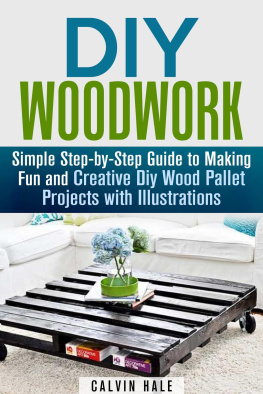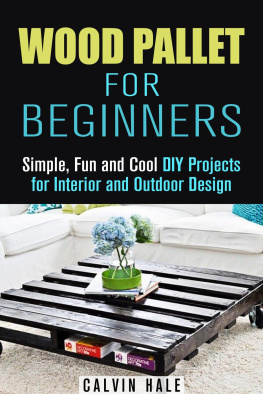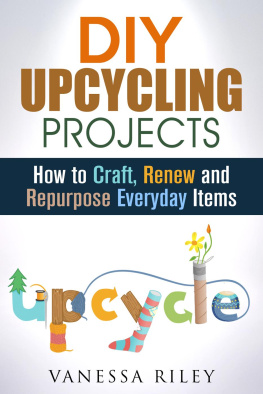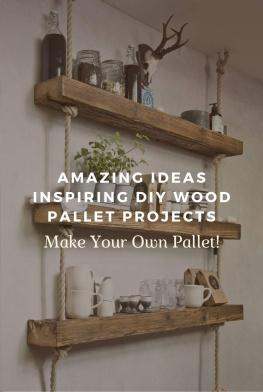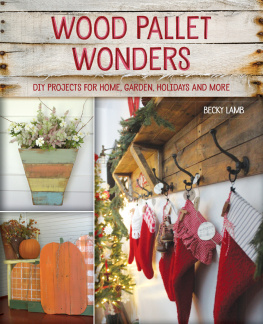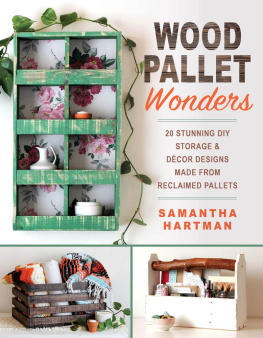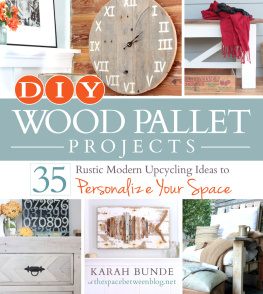DIY Woodwork
Simple Step-by-Step Guide to Making Fun and Creative DIY Wood Pallet Projects with Illustrations
Copyright Notice
Reproduction, duplication, transmission of this document in part or in whole is permitted only with written permission from the publisher. All rights reserved.
Respective brands and trademarks mentioned in this book belong to their respective owners.
Disclaimer
This document is geared towards providing summarization of information related to the topic. While all attempts have been made to verify the accuracy of the information, the author does not assume any responsibility for errors, omissions, or interpretations of the content. The information is offered for informational or entertainment purposes only. If professional advice is necessary, a qualified legal, medical, financial or another respective professional should be consulted. The reader is responsible for his or her own actions. The publisher does not accept any responsibility or liability arising from damages or losses, real or perceived, direct or indirect, resulting from the use of this information.
Table of Contents
Introduction
P allets are flat structures that are used to transport goods. They can be lifted by a pallet jack or a forklift when theyre full, or any other jack device. Pallets are sometimes known as skids and are the foundation of a unit load design. They can be made of wood, plastic, metal, and even paper.
The expanding use of using containers for the transportation of goods has resulted in an increased usage of pallets because the containers have clean and level surfaces that are suited for the movement and storage of a loaded pallet. Most pallets have a load bearing capacity that exceeds about a ton or two thousand pounds.
Every year, half a billion are manufactured in the United States and more than two billion pallets are in use at one time. Theyre more efficient and cost effective because the goods can be moved faster with very little manpower. Organizations that utilize pallets for transport have a lower cost of handling and transportation than organizations that dont.
So why recycle pallets for DIY projects?
In the United States, only home construction comes above the construction of pallets when it comes to the use of wood. A pallet has a limited useful life, in some cases, because it has to meet specifications in order to continue to be useful. Once damage of any kind has occurred, theyre considered unsafe for shipping and they are cast aside.
Recycling these pallets can be more cost beneficial to a company because of the reduction of the initial production cost. Recycled pallets prove to be stronger and stiffer because the wood is seasoned and can be stronger than boards used for the first time. Thats why a pallet thats already been used can be a really great find. Stronger boards mean they resist breakage, and this means theres less chance of a pallet bed breaking.
So what can you do with a pallet?
- Make an outdoor stairway for a treehouse
- Build a fence
- Make a planter
- Make a table
- Make a coffee table
- Make a strawberry planter
- Make a coat rack
- Make a vintage ice chest
- Make a bench
- Make a shadow box
- Make a gun rack
- Make a wine rack
- And so much more!
Recycled wood is usually drier than other woods and has less water than new boards, which means less mold, corrosion, and mildew. This can increase the life of the pallet and what its being used for. Of course, the most benefit from a recycled wood pallet is that its excellent for the environment and there's an enormous saving of valuable natural resources.
Plastic pallets are also able to be recycled. Crumbling devices at factories will turn plastic pallets into pellets that can be remade into playground equipment, mold landscape accessories, floor mats, and even patio furniture. The costs are higher because of the cost of the special machinery, but the cost to the environment is worse if the pallets are discarded.
However, the cost of obtaining a pallet from a business that no longer wants it can be free!
When it comes to the style of the pallet, most people think theyre all the same. However, there is a variety of different types of pallets. Choosing the right one can mean the difference between using safe materials and using damaged wood that has chemical toxins in it. This can be detrimental to you and your family, so choosing the right pallet is imperative.
Because pallets are used for many different transportation types, theyre exposed to spills of all sorts of products and chemicals. The first rule when selecting a pallet is to look for any sort of nasty liquids that might be on it. Its best to discard anything that has serious stains, spills, or a strange discoloration to it. Stick with a pallet thats stain-free and clean.
Once you find a spotless pallet, the following step is to look for a stamp or mark on the side or stringers of the pallet. If you dont see numbers, symbols, words, etchings, brands, or paint on the side of the pallet, then youve most likely found a clean and safe pallet. For most domestic transportation needs, a non-treated wood pallet does not require markings.
Aside from the companys logo, there are some other markings you might find on the side of the pallet. This means the pallet has most likely been shipped internationally. Along with some symbols, there will be a country of origin abbreviation and a registration number. There are also some other markings you want to keep an eye out for.
- IPPC Logo: If the pallet comes from overseas and doesnt have a seal of approval with IPPC, then you dont know what its been used for or treated with.
- Treatment Code: These are usually found in the lower center of a mark. Its a two to four letter code that tells the tale of what was used to treat that particular pallet. The treatment codes are as follows:
- DB Debarked. This removes the bark using a cutting tool and the pallet wood is not treated with anything. Pallets that have these letters are chemical-free and safe.
- HT Heat-Treated. Heating treating is conducted by putting the pallet into a kiln for thirty minutes to ensure that no bugs will want to get into the pallet and chemicals are not used in the process. That means these pallets are chemical-free and safe to use.
- MB Methyl Bromide. This is a poisonous fungicide that can make people very sick. Its banned in Canada, but pallets marked with MB are still used in most other countries. They should be avoided. If you see one of them, be sure to dispose of it at the proper place.
- EPAL European Pallet Association Logo. This means the pallet was debarked and heat-treated, so its safe.
- EUR Old European Pallet Association Logo. This is the old version of EPAL and should be avoided unless theyre EPAL approved, too.
- Colored Pallets These are used to ship pool chemicals and should be avoided because they can be toxic. Even though they look pretty neat, avoid them for your woodworking projects.
So where can you find a really great pallet thats free from pesticides, chemicals, and other toxins? You can follow a list of safe locations that can help you find a quality supply of free, wooden pallets for the next project you find in this book. Here are a few ideas for you.
- Feed and Tack Supply This is one of the best places to find used pallets because feed and tack supply stores use pallets made from soft woods that dont carry toxins. They carry animal food supplies.
- Residential Construction Sites Pallets that carry cement, joint compound, and felt paper can be found at these locations, and theyre all non-toxic materials. Just be sure to ask the builder before you take it from a residential construction site to avoid confusion. In addition, avoid commercial construction sites because they can have toxic pallets.
Next page
